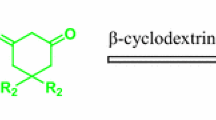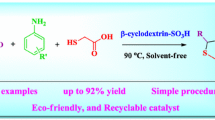Abstract
A high-efficiency microwave irradiation (MW) assisted protocol was proposed to synthesize series SPE-β-CD with specific degree of substitution (DS) in the sodium hydroxide solution. This protocol provided an eco-friendly way to modify the cyclodextrins with bulky sulfopropyl substituent on the purpose of avoiding organic solvents and high quantities of thermal energy. Temperature and energy distribution became more uniform under the new method accordingly. Therefore, not only the reaction time reduced significantly from over 20 h to a few hours, but also the DS increased up according to 1H NMR spectroscopy, MS and elemental analysis results. Most importantly, the effects of reaction parameters on DS were compared both under MW method and conventional heating method, and were sufficiently studied to guarantee the aforementioned results could be better reproduced and DS of products could become more specific through the synthesis process. Products structures were characterized by FT-IR, DSC, and 13C NMR spectroscopy.





Similar content being viewed by others
References
Chen, Y., Liu, Y.: Construction and functions of cyclodextrin-based 1D supramolecular strands and their secondary assemblies. Adv. Mater. 27, 5403–5409 (2015). https://doi.org/10.1002/adma.201501216
Wang, J., Wei, M., Rao, G., Evans, D.G., Duan, X.: Structure and thermal decomposition of sulfated β-cyclodextrin intercalated in a layered double hydroxide. J. Solid State Chem. 177(1), 366–371 (2004). https://doi.org/10.1016/j.jssc.2003.09.006
Ambrus, R., Aigner, Z., Catenacci, L., Bettinetti, G., Szabó-Révész, P., Sorrenti, M.: Physico-chemical characterization and dissolution properties of nifluminic acid-cyclodextrin-PVP ternary systems. J. Therm. Anal. Calorim. 104(1), 291–297 (2010). https://doi.org/10.1007/s10973-010-1069-1
Chekirou, N.L., Benomrane, I., Lebsir, F., Krallafa, A.M.: Theoretical and experimental study of the tetracain/β-cyclodextrin inclusion complex. J. Incl. Phenom. Macrocycl. Chem. 74(1–4), 211–221 (2012). https://doi.org/10.1007/s10847-011-0102-8
Zielenkiewicz, W., Koźbiał, M., Golankiewicz, B., Poznański, J.: Enhancement of aqueous solubility of tricyclic acyclovir derivatives by their complexation with hydroxypropyl-β-cyclodextrin. J. Therm. Anal. Calorim. 101(2), 555–560 (2010). https://doi.org/10.1007/s10973-010-0847-0
Huang, D., Zhang, Y., Zhang, H.: A novel synthesis of ethyl carbonate derivatives of beta-cyclodextrin. Carbohydr. Res. 370, 82–85 (2013). https://doi.org/10.1016/j.carres.2013.01.022
Caliceti, P., Salmaso, S., Semenzato, A.: Synthesis and physicochemical characterization of Folate-Cyclodextrin Bioconjugate for active drug delivery. Bioconjugate Chem. 14(5), 899–908 (2003)
Vahid Z., Roger A.R., Esteban R.B.: Effect of alkyl chain length and degree of substitution on the complexation of sulfoalkyl ether beta-cyclodextrins with steroids. J. Pharm. Sci. 86(2), 220–224 (1997). https://doi.org/10.1021/js960236u
Song, A., Wang, J., Liu, C., Deng, L.: Sulfoalkyl ether β-cyclodextrin derivatives synthesized by a single step method as pharmaceutical biomaterials. Chin. Sci. Bull. 54(18), 3187–3199 (2009). https://doi.org/10.1007/s11434-009-0262-8
Zia, V., Rajewski, R.A., Bornancini, E.R., Luna, E.A., Stella, V.J.: Effect of alkyl chain length and degree of substitution on the complexation of sulfoalkyl ether beta-cyclodextrins with steroids. J. Pharm. Sci. 86(2), 220–224 (1997). https://doi.org/10.1021/js960236u
Kirschner, D.L., Green, T.K.: Nonaqueous synthesis of a selectively modified, highly anionic sulfopropyl ether derivative of cyclomaltoheptaose (beta-cyclodextrin) in the presence of 18-crown-6. Carbohydr. Res. 340(11), 1773–1779 (2005). https://doi.org/10.1016/j.carres.2005.04.012
Ilisz, I., Fodor, G., Berkecz, R., Ivanyi, R., Szente, L., Peter, A.: Enantioseparation of beta-substituted tryptophan analogues with modified cyclodextrins by capillary zone electrophoresis. J. Chromatogr. A 1216(15), 3360–3365 (2009). https://doi.org/10.1016/j.chroma.2009.01.083
Kirschner, D., Green, T., Hapiot, F., Tilloy, S., Leclercq, L., Bricout, H., Monflier, E.: Heptakis(2,3-di-O-methyl-6-O-sulfopropyl)-β-cyclodextrin: a genuine supramolecular carrier for aqueous organometallic catalysis. Adv. Synth. Catal. 348(3), 379–386 (2006). https://doi.org/10.1002/adsc.200505417
Chen, W., Wan, X., Xu, N.: Ordered conducting polypyrrole doped with sulfopropyl ether of β-cyclodextrin. Macromolecules 36, 276–278 (2003)
Ma, D.-Y., Zhang, Y.-M., Xu, J.-N.: The synthesis and process optimization of sulfobutyl ether β-cyclodextrin derivatives. Tetrahedron. 72(22), 3105–3112 (2016). https://doi.org/10.1016/j.tet.2016.04.039
Tongiani, S., Velde, D.V., Ozeki, T., Stella, V.J.: Sulfoalkyl ether-alkyl ether cyclodextrin derivatives, their synthesis, NMR characterization, and binding of 6alpha-methylprednisolone. J. Pharm. Sci. 94(11), 2380–2392 (2005). https://doi.org/10.1002/jps.20367
Qi, Q., Edward, T., Sherril, D.C.: Sulfoalkyl ether beta-cyclodextrin derivatives synthesis and characterizations. J. Incl. Phenom. Macrocycl. Chem. 43, 213–221 (2002)
Biswas, A., Appell, M., Liu, Z., Cheng, H.N.: Microwave-assisted synthesis of cyclodextrin polyurethanes. Carbohydr. Polym. 133, 74–79 (2015). https://doi.org/10.1016/j.carbpol.2015.06.044
Stass, D.V., Woodward, J.R., Timmel, C.R., Hore, P.J.: Radiofrequency magnetic field effects on chemical reation yields. Chem. Phys. Lett. 329, 15–22 (2000)
Martina, K., Cravotto, G., Caporaso, M., Rinaldi, L., Villalonga-Barber, C., Ermondi, G.: Efficient microwave-assisted synthetic protocols and in silico behaviour prediction of per-substituted beta-cyclodextrins. Org. Biomol. Chem. 11(33), 5521–5527 (2013). https://doi.org/10.1039/c3ob40909k
Puglisi, A., Spencer, J., Clarke, J., Milton, J.: Microwave-assisted synthesis of 6-amino-β-cyclodextrins. J. Incl. Phenom. Macrocycl. Chem. 73(1–4), 475–478 (2011). https://doi.org/10.1007/s10847-011-0054-z
Roy, A., Saha, S., Roy, M.N.: Exploration of inclusion complexes of probenecid with α and β-cyclodextrins: Enhancing the utility of the drug. J. Mol. Struct. 1144, 103–111 (2017). https://doi.org/10.1016/j.molstruc.2017.05.002
Nafee, N., Hirosue, M., Loretz, B., Wenz, G., Lehr, C.M.: Cyclodextrin-based star polymers as a versatile platform for nanochemotherapeutics: enhanced entrapment and uptake of idarubicin. Colloids Surf. B 129, 30–38 (2015). https://doi.org/10.1016/j.colsurfb.2015.03.014
Peng, J., Wang, Y., Wang, J., Zhou, X., Liu, Z.: A new biosensor for glucose determination in serum based on up-converting fluorescence resonance energy transfer. Biosens. Bioelectron. 28(1), 414–420 (2011). https://doi.org/10.1016/j.bios.2011.07.057
Ge, D.-L., Zhang, X.-Z., Chen, S.-Y., Pu, L., Yu, X.-Q.: Microwave-assisted synthesis of 2-pyridinylethyl indazoles. Tetrahedron Lett. 56(33), 4811–4814 (2015). https://doi.org/10.1016/j.tetlet.2015.06.065
Mangolim, C.S., Moriwaki, C., Nogueira, A.C., Sato, F., Baesso, M.L., Neto, A.M., Matioli, G.: Curcumin-beta-cyclodextrin inclusion complex: stability, solubility, characterisation by FT-IR, FT-Raman, X-ray diffraction and photoacoustic spectroscopy, and food application. Food Chem. 153, 361–370 (2014). https://doi.org/10.1016/j.foodchem.2013.12.067
Zia, V., Vander Velde, D., Stella, V.J.: Extrathermodynamic relations in the binding of charged and neutral substrates to sulfobutylether-β-CDs (SBE-β-CDs) and a 2-hydroxypropyl-β-CD (HP-β-CD). J. Incl. Phenom. Macrocycl. Chem. 79(3–4), 503–512 (2013). https://doi.org/10.1007/s10847-013-0374-2
Mazinani, S.A., DeLong, B., Yan, H.: Microwave radiation accelerates trypsin-catalyzed peptide hydrolysis at constant bulk temperature. Tetrahedron Lett. 56(42), 5804–5807 (2015). https://doi.org/10.1016/j.tetlet.2015.09.003
Yallapu, M.M., Jaggi, M., Chauhan, S.C.: Beta-cyclodextrin-curcumin self-assembly enhances curcumin delivery in prostate cancer cells. Colloids Surf. B 79(1), 113–125 (2010). https://doi.org/10.1016/j.colsurfb.2010.03.039
Xu, J., Zhang, Y., Li, X., Zheng, Y.: Inclusion complex of nateglinide with sulfobutyl ether β-cyclodextrin: preparation, characterization and water solubility. J. Mol. Struct. 1141, 328–334 (2017). https://doi.org/10.1016/j.molstruc.2017.03.116
Shinde, V.V., Jeong, D., Joo, S.W., Cho, E., Jung, S.: Mono-6-deoxy-6-aminopropylamino-β-cyclodextrin as a supramolecular catalyst for the synthesis of indolyl 1 H-pyrrole via one-pot four component reaction in water. Catal. Commun. 103, 83–87 (2018). https://doi.org/10.1016/j.catcom.2017.10.001
Ortiz Mellet, C., Garcia Fernandez, J.M., Benito, J.M.: Cyclodextrin-based gene delivery systems. Chem. Soc. Rev. 40(3), 1586–1608 (2011). https://doi.org/10.1039/c0cs00019a
Liu, W., Li, C., Gu, Y., Tang, L., Zhang, Z., Yang, M.: One-step synthesis of β-cyclodextrin functionalized graphene/Ag nanocomposite and its application in sensitive determination of 4-Nitrophenol. Electroanalysis (2013). https://doi.org/10.1002/elan.201300227
Acknowledgements
This work was supported by grants from AnBaoLiHeng Co. Ltd. (Tianjin City, China). We thank Dr. Qiao B. for his help with MS characterization, Dr. Ding G. for his help with NMR characterization, Dr. Jin X H. for his help with IR characterization, and Dr. Dun W.Q. for DSC.
Author information
Authors and Affiliations
Corresponding author
Rights and permissions
About this article
Cite this article
Li, X., Zhang, Y., Xu, J. et al. Efficient production of series sulfopropyl ether β-cyclodextrin derivatives using the eco-friendly microwave technique. J Incl Phenom Macrocycl Chem 91, 115–124 (2018). https://doi.org/10.1007/s10847-018-0806-0
Received:
Accepted:
Published:
Issue Date:
DOI: https://doi.org/10.1007/s10847-018-0806-0




